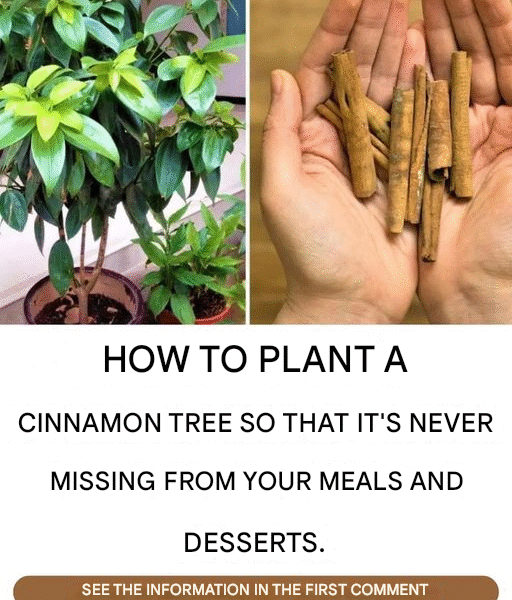How to Plant a Cinnamon Tree So It’s Never Missing from Your Meals and Desserts
Cinnamon is more than just a warm, fragrant spice — it’s a natural treasure that adds richness to countless meals, desserts, and drinks. What if you could have fresh cinnamon growing right at home, always ready to be harvested and enjoyed? The great news is: you can grow your very own cinnamon tree, even in a backyard or large pot, and keep this beloved spice within reach all year round!
Here’s everything you need to know about how to plant, grow, and harvest cinnamon — from seedling to sweet spice.
What Is a Cinnamon Tree?
The cinnamon we use in the kitchen comes from the inner bark of the Cinnamomum tree, a tropical evergreen native to Sri Lanka and Southeast Asia. The two most common types are:
- Ceylon Cinnamon (Cinnamomum verum) – known as “true cinnamon,” with a delicate, sweet flavor
- Cassia Cinnamon (Cinnamomum cassia) – stronger and more commonly found in stores
Both can be grown at home with the right care!
How to Plant a Cinnamon Tree at Home
1. Choose the Right Environment
- Climate: Cinnamon trees thrive in warm, humid environments (USDA zones 9–11). If you live in a cooler area, you can grow it indoors or in a greenhouse.
- Sunlight: Needs partial to full sunlight (at least 6 hours daily).
- Soil: Use well-draining, slightly acidic soil rich in organic matter. A potting mix with peat moss, compost, and sand works well.
2. Get a Seedling or Starter Plant
Growing cinnamon from seed is slow and difficult. Instead, buy a small cinnamon sapling from a reputable nursery for faster results.
3. Planting Instructions
- If in a pot: Choose one that’s at least 12 inches deep with good drainage holes.
- If in ground: Dig a hole twice as wide as the root ball.
- Place the seedling and fill in with rich, loose soil.
- Water thoroughly after planting.
How to Care for Your Cinnamon Tree
Watering:
Keep the soil moist but not soggy. Water deeply 2–3 times per week, more often in hot weather.
Feeding:
Fertilize every 4–6 weeks during growing season (spring to early fall) with a balanced organic fertilizer.
Pruning:
Trim the tree annually to encourage bushy growth and keep it manageable in size. This also stimulates bark development — the part used for spice.
Pest Control:
Cinnamon trees are relatively pest-resistant. Use natural insecticidal soap if needed.
When and How to Harvest Cinnamon
Cinnamon can be harvested once the tree is 2–3 years old. Here’s how:
- Cut a small branch (1–2 inches thick) from the tree.
- Peel off the outer bark to reveal the fragrant inner bark.
- Carefully strip the inner bark in long rolls — it will naturally curl into cinnamon sticks as it dries.
- Let the bark dry in a warm, dry place for 7–10 days.
- Store in an airtight container for use in teas, stews, desserts, and baking.
Why Grow Your Own Cinnamon?
✔️ Always have fresh, chemical-free spice at hand
✔️ Save money on store-bought cinnamon
✔️ Enjoy a beautiful, fragrant tree in your garden or home
✔️ Use bark, leaves, and even oil for natural remedies and aromatherapy
Plus, there’s something deeply satisfying about cooking and baking with cinnamon you’ve grown yourself!
In Conclusion
With a little care and patience, you can grow your own cinnamon tree and never run out of this magical spice again. It’s a rewarding way to bring flavor, beauty, and nature into your kitchen — all year round.
🌱🍂 If you loved this gardening tip, don’t forget to LIKE, SHARE, and FOLLOW for more plant-growing guides and natural living inspiration! Let’s grow together! 🌿💚
